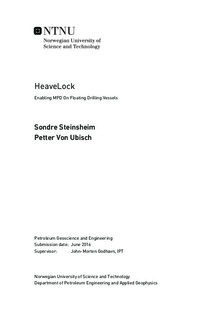HeaveLock - Enabling MPD On Floating Drilling Vessels
Master thesis
Permanent lenke
http://hdl.handle.net/11250/2397725Utgivelsesdato
2016Metadata
Vis full innførselSamlinger
Sammendrag
During drilling operations from floating drilling vessels, it is often experienced challenges related to heave motions when the rig s heave compensating system is deactivated. Rig heave movements cause the bottom hole pressure (BHP) to increase and decrease, known as surge and swab respectively. Pressure fluctuations are potentially a major issue in Managed Pressure Drilling (MPD) operations, where the drilling window typically is narrow.
NTNU, in cooperation with Statoil, are developing a bottom hole assembly (BHA) component that will reduce these problematic surge and swab pressures. The component is called HeaveLock.
This thesis is continued work from the specialization project HeaveLock (Steinsheim & von Ubisch, 2015). In short, the project lacked a robust friction model and an advanced control system for the HeaveLock component. These issues are addressed in this master s thesis.
To solve the assignment, an improved fluid- and hydraulic friction model, as well as a more elegant HeaveLock control was implemented to a MS Excel workbook. The workbook is capable of calculating flow rates, pressure states and pressure losses in detail over a 400 s period. The thesis presents a base case that is decomposed to examine the individual impacts friction and compression have on the BHP fluctuations. A sensitivity analysis is then conducted to identify the dominating variables of the system.
Calculations reveal that friction is the dominating effect in the BHP fluctuations, and is about 3,5 times greater than the BHP fluctuations caused by compression. With the variables given in the base case, the HeaveLock is able to reduce the BHP fluctuations by 77 %.
The sensitivity analysis identifies that the initial HeaveLock opening and pressure loss over the HeaveLock at fully open are the most sensitive factors with relation to the HeaveLock efficiency. BHP fluctuations with the HeaveLock inactive are most sensitive to clinging factor, heave- height and period, drill pipe (DP) dimensions and well length.
